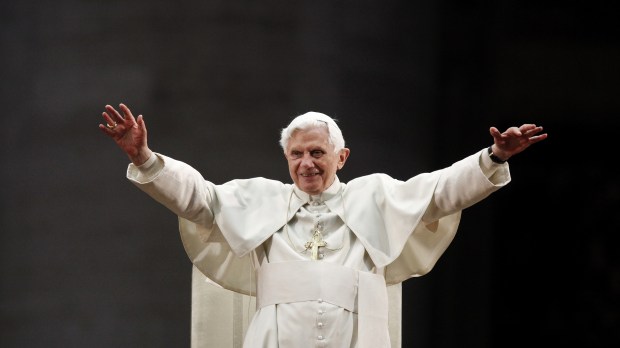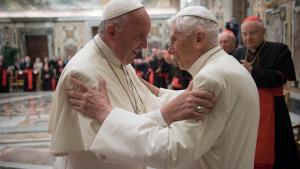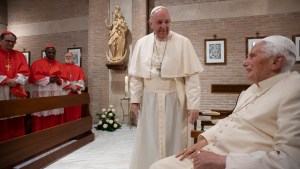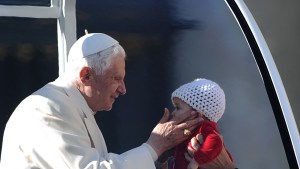Pope Emeritus Benedict XVI has died. The 95-year-old pontiff passed away in the Vatican’s Mater Ecclesiae Monastery on December 31 at 9:34 a.m. He passed in the monastery where he has lived for most of the past nine years, since his historic resignation from the papacy in 2013.
Benedict’s death marks the first time in six centuries that a Successor of St. Peter has died while not in office. The last was Pope Gregory XII. But that is only one of many fascinating parts to Joseph Alois Ratzinger’s life. He was a man — and a pope — of many surprises.
“Cardinal Ratzinger/Pope Benedict’s intellectual brilliance and gentle demeanor became well known to all soon after his election to the papacy,” said Jesuit Fr. Joseph Fessio, founder of Ignatius Press and a former doctoral student under Ratzinger’s direction. “People suddenly realized that the Panzerkardinal, the Vatican Enforcer, the humorless, predatory doctrinal watchdog was in fact none of these things. Quite the opposite in fact.”
A surprisingly long life
Pope Benedict might have surprised himself in living as long as he did. In February 2018, the German weekly Neue Post published an interview with Msgr. Georg Ratzinger (brother of the former pope who died in July 2020) saying Benedict was suffering from a nerve disease, which was paralyzing him little by little. That was later denied by the Vatican.
But the week before, the Italian daily newspaper Il Corriere della Sera published a letter from Benedict himself in which he seemed to be hinting to his imminent passing.
“As my physical strength slowly wanes, interiorly I am on a pilgrimage towards Home,” the Pope Emeritus wrote, in the Feb. 5, 2018, letter.
On April 1, 2021, the German periodical Die Tagespost reported remarks by Benedict XVI’s longtime secretary, Archbishop Georg Gänswein, who revealed that Benedict only expected to live a few months after his resignation.
“It seemed to him, as well as to me — I can confess it here — that he only had a few months left, but not eight years,” Gänswein said during an Austrian psychiatry congress.
But as late as January 2020, the Pope Emeritus was still making news. A book called From the Depths of Our Hearts: Priesthood, Celibacy and the Crisis of the Catholic Church was seen as a last-ditch effort to sway Pope Francis from opening up the possibility of ordaining married men to the priesthood. It initially bore Pope Benedict’s name as co-author, along with Cardinal Robert Sarah, though it later came out that the Pope Emeritus had not co-authored it.
Historic resignation
In his last years, though, Pope Benedict led a mostly private, quiet life in a room of a former convent in the Vatican.
“Benedict XVI, since his resignation, has understood himself as an old monk who, after February 28, 2013, is committed above all to prayer for Mother Church and his successor, Pope Francis, and for the Petrine ministry founded by Christ himself,” Archbishop Gänswein said in a talk in Rome in September 2018.
Benedict didn’t make public appearances in the last years, but still received visitors, who often shared pictures of their time together on social media.
After his retirement, the Pope Emeritus only appeared for a few special events in the Vatican, such as visiting St. Peter’s Basilica in 2015 to take part in the official inauguration of the Jubilee of Mercy with the opening of the Holy Door. Pope Francis greeted him in the atrium of the basilica before conducting the ceremony to open the Holy Door and then walked through it. Benedict followed, assisted by Archbishop Gänswein.
Even when he was elected to the Chair of St. Peter, there was concern about his health. At 78, he was the oldest pope to be elected since Clement XII in 1730. The new pope himself predicted that he would have a short papacy.
Pope Benedict said that he resigned from the papacy because of a “lack of strength of mind and body” due to advanced age. He felt that the office was increasingly becoming a burden on him and that he could not fulfill his duties sufficiently.
But it was an extremely rare action that had not occurred since 1415, when Pope Gregory XII stepped down. Some observers speculated causes other than health, including the leaking of documents to the press by Benedict’s private butler and infighting in the Vatican Curia.
Major writings
Cardinal Joseph Ratzinger had been the head of the Vatican Congregation for the Doctrine of the Faith for almost 24 years under Pope John Paul II when he was elected to succeed the Polish pope in April 2005. With Wojtyla, the College of Cardinals had broken the long tradition of electing Italians to the papacy, and Ratzinger became the first German to become pope since the 16th-century Adrian VI.
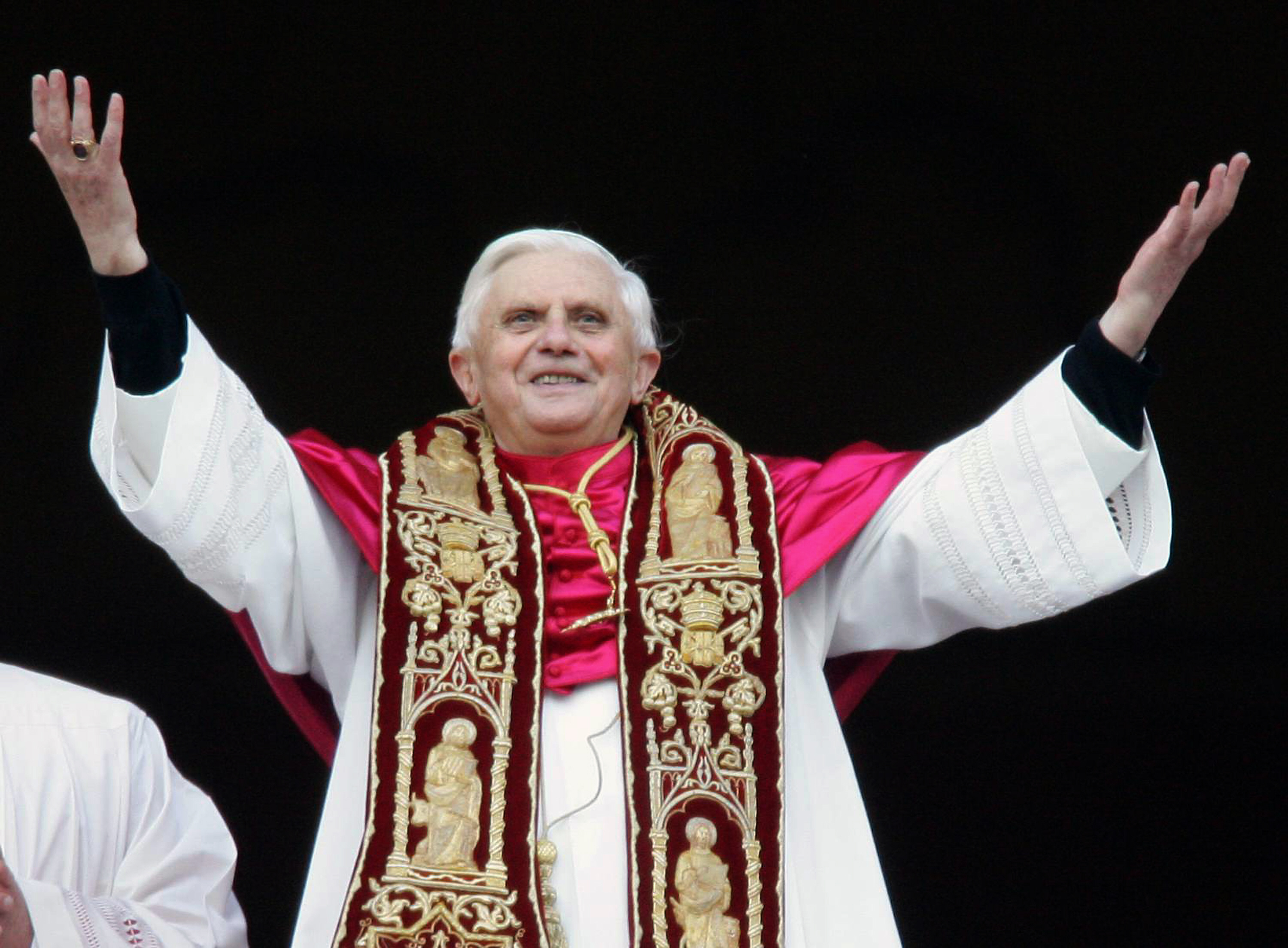
He was the 265th pope.
Though his eight-year tenure was brief in comparison to John Paul’s 26, he was far more than simply a caretaker or placeholder. Among other accomplishments, he oversaw the establishment of a process for Anglican congregations to enter the Catholic Church while maintaining their special liturgical traditions, and continued his predecessor’s tradition of meeting with the youth of the world every three or so years in a major gathering called World Youth Day.
During his pontificate, he published three encyclicals, His first, Deus Caritas Est, in 2006 took up the theme of love, with Part I presenting a theological and philosophical reflection on the different dimensions of love — eros, philia, agape — and explaining certain essential facts concerning God’s love for man and the intrinsic connection of this love with human love. Part II deals with the actual practice of the commandment to love one’s neighbor.
The following year, in Spe Salvi, he said that, without faith in God, humanity lies at the mercy of ideologies that can lead to “the greatest forms of cruelty and violations of justice.”
Caritas in veritate, his third and last encyclical, was released in 2009. It is, in the words of the U.S. Conference of Catholic Bishops, a “call to see the relationship between human and environmental ecologies and to link charity and truth in the pursuit of justice, the common good, and authentic human development.”
“In doing so, the pope points out the responsibilities and limitations of government and the private market, challenges traditional ideologies of right and left, and calls all men and women to think and act anew,” said the bishops’ conference.
While Deus Caritas Est and Spe Salvi covered the theological virtues of love and hope, Benedict had completed a draft of a fourth encyclical to discuss faith. But it was not published by the time Benedict stepped down. His successor, Pope Francis, completed and published Lumen Fidei in June 2013, four months into the new pontificate. Francis, in paragraph 7 of the encyclical, acknowledges this fact.
“These considerations on faith — in continuity with all that the Church’s magisterium has pronounced on this theological virtue — are meant to supplement what Benedict XVI had written in his encyclical letters on charity and hope,” Francis wrote. “He himself had almost completed a first draft of an encyclical on faith. For this I am deeply grateful to him, and as his brother in Christ I have taken up his fine work and added a few contributions of my own.”
Among his many publications are Introduction to Christianity, a compilation of university lectures on the Creed published in 1968; The Ratzinger Report; a book-length interview on the state of the Church (1985); Salt of the Earth (1997); and Jesus of Nazareth, a life of Christ in three volumes published during his pontificate.
The dictatorship of relativism
In other writings and speeches, Benedict addressed the contemporary problem he called the “dictatorship of relativism.”
“Today, a particularly insidious obstacle to the task of education is the massive presence in our society and culture of that relativism which, recognizing nothing as definitive, leaves as the ultimate criterion only the self with its desires,” he said in an address in Rome in 2005. “And under the semblance of freedom it becomes a prison for each one, for it separates people from one another, locking each person into his or her own ego.”
He also responded to continuing and relatively new challenges to traditional understandings of love, marriage and the sacredness of human life. The same year, 2005, he remarked that the “various forms of the dissolution of matrimony today, like free unions, trial marriages and going up to pseudo-matrimonies by people of the same sex, are rather expressions of an anarchic freedom that wrongly passes for true freedom of man…. From here it becomes all the more clear how contrary it is to human love, to the profound vocation of man and woman, to systematically close their union to the gift of life, and even worse to suppress or tamper with the life that is born.”
The Pope became the center of controversy when he delivered a lecture at his old university in Regensburg. The September 2006 talk, “Faith, Reason and the University — Memories and Reflections,” included a quote from a 14th-century Byzantine emperor: “Show me just what Muhammad brought that was new and there you will find things only evil and inhuman, such as his command to spread by the sword the faith he preached.”
Although it was merely a quote, and not the Pope’s own sentiments, it caused an uproar across the Muslim world. Benedict attempted to make amends by praying in the Sultan Ahmed Mosque when he visited Istanbul later that year.
This wasn’t the only time his speeches made big news. In a 2010 book-length interview with German journalist Peter Seewald, Light of the World: The Pope, the Church, and the Signs of the Times, Pope Benedict made a comment that was immediately judged as a new openness on the part of the Church to the use of condoms to prevent the spread of the AIDS virus. In fact, Benedict was merely saying that if a male prostitute were to choose to wear a condom during sex, it could be taken as a sign that he had some inchoate moral sense because he was trying at least not to infect someone else.
Unknown by many
In spite of his gentle, grandfatherly demeanor, an image perdured in the public imagination of an unbending, doctrinaire enforcer of Catholic theology, especially moral theology — the “Vatican Enforcer,” as Fr. Fessio put it.
Even in the twilight of his life, a movie produced by Netflix, The Two Popes, depicted him as the stern, doctrinaire foil to his eventual successor, a portrayal that drew sharp criticism from many Catholic thinkers.
“If only we had had a flashback to the sixteen-year-old boy from a fiercely anti-Nazi family, pressed into military service in the dying days of the Third Reich, we would understand more thoroughly Ratzinger’s deep suspicion of secularist/totalitarian utopias and cults of personality,” wrote Bishop Robert Barron in a January 2, 2020, review of the film. “If only we had had a flashback to the young priest, peritus to Cardinal Frings, leading the liberal faction at Vatican II and eager to turn from preconciliar conservatism, we would have understood that he was no simple-minded guardian of the status quo. If only we had had a flashback to the Tubingen professor, scandalized by a postconciliar extremism that was throwing the theological baby out with the bathwater, we might have understood his reticence regarding programs advocating change for the sake of change. If only we had had a flashback to the Prefect for the Congregation for the Doctrine of the Faith composing a nuanced document, both thoughtfully critical and deeply appreciative of Liberation Theology, we might have grasped that Pope Benedict was by no means indifferent to the plight of the poor.”
Family history
The fact that Ratzinger’s youth coincided with the rise of National Socialism in Germany gave detractors an opening to label him as the Panzerkardinal. Born at Marktl am Inn, Bavaria — the country’s most Catholic area — on April 16, 1927, Joseph Alois Ratzinger was baptized on the same day, which was Holy Saturday that year.
According to his official biography at the Vatican’s website, his father, a policeman, belonged to an old family of farmers from Lower Bavaria of modest economic resources. His mother was the daughter of artisans from Rimsting on the shore of Lake Chiem, and before marrying she worked as a cook in a number of hotels.
Besides Joseph, the Ratzingers also had a daughter, Maria, who managed the cardinal’s household until her death in 1991, and another son, Georg, who would gain prominence in his own right as the director of the Regensburger Domspatzen choir.
Joseph spent his childhood and adolescence in Traunstein, a small village near the Austrian border, about 19 miles from Salzburg. As he grew up, Adolf Hitler gained more and more power, and the Nazi regime developed a hostile attitude towards the Church. Joseph saw how some Nazis beat the parish priest before the celebration of Mass.
And yet, as his Vatican biography put it, “It was during that complex situation that he discovered the beauty and truth of faith in Christ; fundamental for this was his family’s attitude, who always gave a clear witness of goodness and hope, rooted in a convinced attachment to the Church.”
Resisting Hitler
The adolescent Ratzinger was forced to join the Hitler Youth but was unenthusiastic about it and refused to attend meetings. In 1941, one of his cousins, a 14-year-old boy with Down syndrome, was taken away and was never seen again, probably a victim of the Action T4 campaign of Nazi eugenics.
In 1943, Joseph was drafted into the German anti-aircraft auxiliary corps, serving until September 1944. When he turned 18, in April 1945, he had to join the infantry, but did not see combat. The Third Reich was about to fall. In his memoirs, Milestones, he recounted how he deserted the unit and was captured by American troops but released a few weeks later.
After the war, he studied at the Higher School of Philosophy and Theology of Freising and at the University of Munich and was ordained a priest, along with his brother, in 1951. A year later he began teaching at the Higher School of Freising.
The professor
In 1953 he earned a doctorate in theology with a thesis about St. Augustine. Four years later, under the direction of the renowned professor of fundamental theology Gottlieb Söhngen, he qualified for university teaching with a dissertation on “The Theology of History in St. Bonaventure.” He taught at Bonn, which at that time was the capital of West Germany, from 1959 to 1963; Münster from 1963 to 1966; and Tübingen from 1966 to 1969. During this last year he held the Chair of dogmatics and history of dogma at the University of Regensburg.
From 1962 to 1965 — during the Second Vatican Council — he was a peritus, or theological advisor, to Cardinal Joseph Frings, Archbishop of Cologne. Subsequently, he held positions serving the German Bishops’ Conference and the International Theological Commission.
In 1972, together with Hans Urs von Balthasar, Henri de Lubac and other prominent theologians, he initiated the theological journal “Communio.”
On March 25, 1977, Pope Paul VI named him Archbishop of Munich and Freising. On May 28 of the same year he was ordained as a bishop, choosing as his episcopal motto Cooperatores Veritatis, “Cooperators of the truth.”
“On the one hand I saw it as the relation between my previous task as professor and my new mission,” he explained. “In spite of different approaches, what was involved, and continued to be so, was following the truth and being at its service. On the other hand I chose that motto because in today’s world the theme of truth is omitted almost entirely, as something too great for man, and yet everything collapses if truth is missing.”
Paul VI made him a cardinal during the Consistory of June 27, 1977, and when the Pope died the following August, Ratzinger took part in the conclave that elected Albino Luciani to the Chair of Peter. The new pope, John Paul I, who lived a mere 33 days, named Cardinal Ratzinger his Special Envoy to the Third Intdeernational Mariological Congress, celebrated in Guayaquil, Ecuador, in September.
At JPII’s side
In October, the German cardinal took part in the conclave that elected Karol Wojtyla as Pope John Paul II.
John Paul named him Prefect of the Congregation for the Doctrine of the Faith and President of the Pontifical Biblical Commission and of the International Theological Commission on Nov. 25, 1981. He was president of the Preparatory Commission for the Catechism of the Catholic Church, which after six years of work (1986-1992) presented the new Catechism to John Paul II.
In the Roman Curia he held membership on the Council of the Secretariat of State for Relations with States; the Congregations for the Oriental Churches, for Divine Worship and the Discipline of the Sacraments, for Bishops, for the Evangelization of Peoples, for Catholic Education, for Clergy, and for the Causes of the Saints. He was also a member of the Pontifical Councils for Promoting Christian Unity, and for Culture; of the Supreme Tribunal of the Apostolic Signatura, and of the Pontifical Commissions for Latin America, “Ecclesia Dei,” for the Authentic Interpretation of the Code of Canon Law, and for the Revision of the Code of Canon Law of the Oriental Churches.
Under Ratzinger’s direction, the congregation sought to correct the work of several Catholic theologians, such as Leonardo Boff, Matthew Fox, and Anthony de Mello.
Dominus Iesus, published by the congregation in the year 2000, reaffirmed that “Salvation is found in no one else [but Christ], for there is no other name under heaven given to men by which we must be saved.”
Fighting sexual abuse
Although he was criticized by some for not doing enough to fight clergy sexual abuse, he oversaw the promulgation of the 2001 Congregation for the Doctrine of the Faith document Sacramentorum Sanctitatis Tutela, which directed that the congregation handle crimes of sexual abuse of minors by priests and provided that all cases involving clerical sexual abuse of minors be reported to the CDF.
Benedict was the first pope ever to meet with victims of abuse, which he did in the United States and Australia in 2008, and again in Malta in 2010. He spoke openly about the crisis some five times during his 2008 visit to the United States alone. He also was the first pope to dedicate a Pastoral Letter on the sex-abuse crisis — his pastoral letter to Ireland.
Pope Francis would often say it was Benedict who was behind the Church’s resolve to confront the crisis head-on, and that he was the pope that brought about the Church’s ongoing fight against these crimes.
He wanted to retire and write
In November 2002 Ratzinger became Dean of the College of Cardinals, a position that would make him a central figure less than three years later, when John Paul would pass away. As dean, Cardinal Ratzinger would preside at the pope’s funeral and preach the homily.
Meanwhile, as the ailing John Paul celebrated what would be his last Holy Week, Cardinal Ratzinger preached the traditional Good Friday Stations of the Cross in the Roman Colosseum, powerfully condemning sexual abuse as “filth” in the Church — “even among those who, in the priesthood, ought to belong entirely to him.”
Ratzinger was elected pope on April 19, 2005, the second day of the conclave. Appearing on the balcony of St. Peter’s Basilica, he said to the crowd gathered in the square:
Dear brothers and sisters, after the great Pope John Paul II, the Cardinals have elected me, a simple, humble laborer in the vineyard of the Lord. The fact that the Lord knows how to work and to act even with insufficient instruments comforts me, and above all I entrust myself to your prayers. In the joy of the Risen Lord, confident of his unfailing help, let us move forward. The Lord will help us, and Mary, His Most Holy Mother, will be on our side.
The German cardinal who had repeatedly (and unsuccessfully) asked Pope John Paul to be allowed to retire to his native Bavaria in order to write books in his old age said later that during the conclave he had prayed to God not to be elected pope. But, he told a group of German pilgrims, “evidently this time He didn’t listen to me.”
Papal name
In his first general audience, he explained the choice of his papal name. “I wanted to be called Benedict XVI in order to create a spiritual bond with Benedict XV, who steered the Church through the period of turmoil caused by the First World War,” he said. “He was a courageous and authentic prophet of peace and strove with brave courage first of all to avert the tragedy of the war and then to limit its harmful consequences. Treading in his footsteps, I would like to place my ministry at the service of reconciliation and harmony between persons and peoples, since I am profoundly convinced that the great good of peace is first and foremost a gift of God, a precious but unfortunately fragile gift to pray for, safeguard and build up, day after day, with the help of all.”
He also said he had in mind St. Benedict of Nursia, known as the “Patriarch of Western Monasticism” and Co-Patron of Europe together with Saints Cyril and Methodius, Bridget of Sweden, Catherine of Siena and Edith Stein. “The gradual expansion of the Benedictine Order that he founded had an enormous influence on the spread of Christianity across the Continent,” the new pope said. “St. Benedict is therefore deeply venerated, also in Germany and particularly in Bavaria, my birthplace; he is a fundamental reference point for European unity and a powerful reminder of the indispensable Christian roots of his culture and civilization.“
“We are familiar with the recommendation that this Father of Western Monasticism left to his monks in his Rule: ‘Prefer nothing to the love of Christ,'” the pope continued. “At the beginning of my service as Successor of Peter, I ask St. Benedict to help us keep Christ firmly at the heart of our lives.”
Cardinal Ratzinger’s ascendance to the throne of St. Peter brought with it several stylistic changes to the Vatican. Though the cardinals swore their obedience to him at his election, the custom of every cardinal submitting to the pope during his inaugural Mass was replaced by having 12 people, including cardinals, clergy, religious, a married couple and their child, and newly confirmed people, greet him. He donned a pallium that he said was closer to the one worn by popes in the Middle Ages.
The German cardinal moved his piano to the apostolic palace and found time to play his favorite Bach and Mozart works.
Papal trips
Though he delegated most beatifications to a cardinal, he himself beatified Cardinal John Henry Newman on a visit to England. Notable canonizations he performed included Mother Theodore Guerin, Jeanne Jugan, André Bessette, Mother Mary MacKillop, Kateri Tekakwitha, and Marianne Cope. He also recognized Saints Hildegard of Bingen and John of Avila as Doctors of the Church. In the Roman Curia, Pope Benedict created the Pontifical Council for the Promotion of the New Evangelization.
His first papal voyage outside of Italy was to his native Germany, when he presided over World Youth Day in Cologne in the summer of 2005.
In 2008, he visited the United States, speaking at the White House and the United Nations and paying his respects to the victims of the Sept. 11, 2001, terror attack at the World Trade Center in New York. In 2009, he visited Africa (Cameroon and Angola) for the first time as pope. During his visit, he suggested that altering sexual behavior was the answer to Africa’s AIDS crisis.
A May 2009 visit to the Middle East brought him to Jordan, Israel, and Palestine.
Addressing an ongoing problem concerning Church-State relations in China, Benedict in 2007 sent a letter to Catholics in the People’s Republic that provided guidance to Chinese bishops on how to respond to illicitly ordained bishops, as well as how to strengthen ties with the Chinese Catholic Patriotic Association and the Communist government.
Ratzinger asteroid
An asteroid, 8661 Ratzinger, was named for him. A NASA website explains that under his supervision, “the Vatican opened its archives in 1998 to enable researchers to investigate judicial errors against Galileo and other medieval scientists.”
Resignation
He stunned the Vatican and the world when on Feb. 11, 2013, he gave a short discourse in Latin, announcing his abdication:
After having repeatedly examined my conscience before God, I have come to the certainty that my strengths, due to an advanced age, are no longer suited to an adequate exercise of the Petrine ministry. I am well aware that this ministry, due to its essential spiritual nature, must be carried out not only with words and deeds, but no less with prayer and suffering. However, in today’s world, subject to so many rapid changes and shaken by questions of deep relevance for the life of faith, in order to govern the barque of Saint Peter and proclaim the Gospel, both strength of mind and body are necessary, strength which in the last few months has deteriorated in me to the extent that I have had to recognize my incapacity to adequately fulfill the ministry entrusted to me. For this reason, and well aware of the seriousness of this act, with full freedom I declare that I renounce the ministry of Bishop of Rome, Successor of Saint Peter, entrusted to me by the Cardinals on 19 April 2005, in such a way, that as from 28 February 2013, at 20:00 hours, the See of Rome, the See of Saint Peter, will be vacant and a Conclave to elect the new Supreme Pontiff will have to be convoked by those whose competence it is.
One of the greats
While he may have been a pope of surprises, all who knew him and his work were never surprised at what he accomplished. Benedict XVI is considered one of the greatest minds in Christendom, and a humble, holy man.
“Joseph Ratzinger will be remembered as one of the truly great Christian minds of the past 100 years; a man who combined faith and reason with elegance and clarity of expression to an extraordinary degree, yet radiated personal humility throughout his life,” Archbishop Emeritus Charles J. Chaput, O.F.M. Cap., of Philadelphia, told Aleteia. “He was the theological partner to Karol Wojtyla’s philosophical genius and a loyal son of Vatican II and its task of authentic reform.”
Aleteia will continue its coverage of Pope Benedict’s death and an expansive appreciation of his life and work in the days to come.
